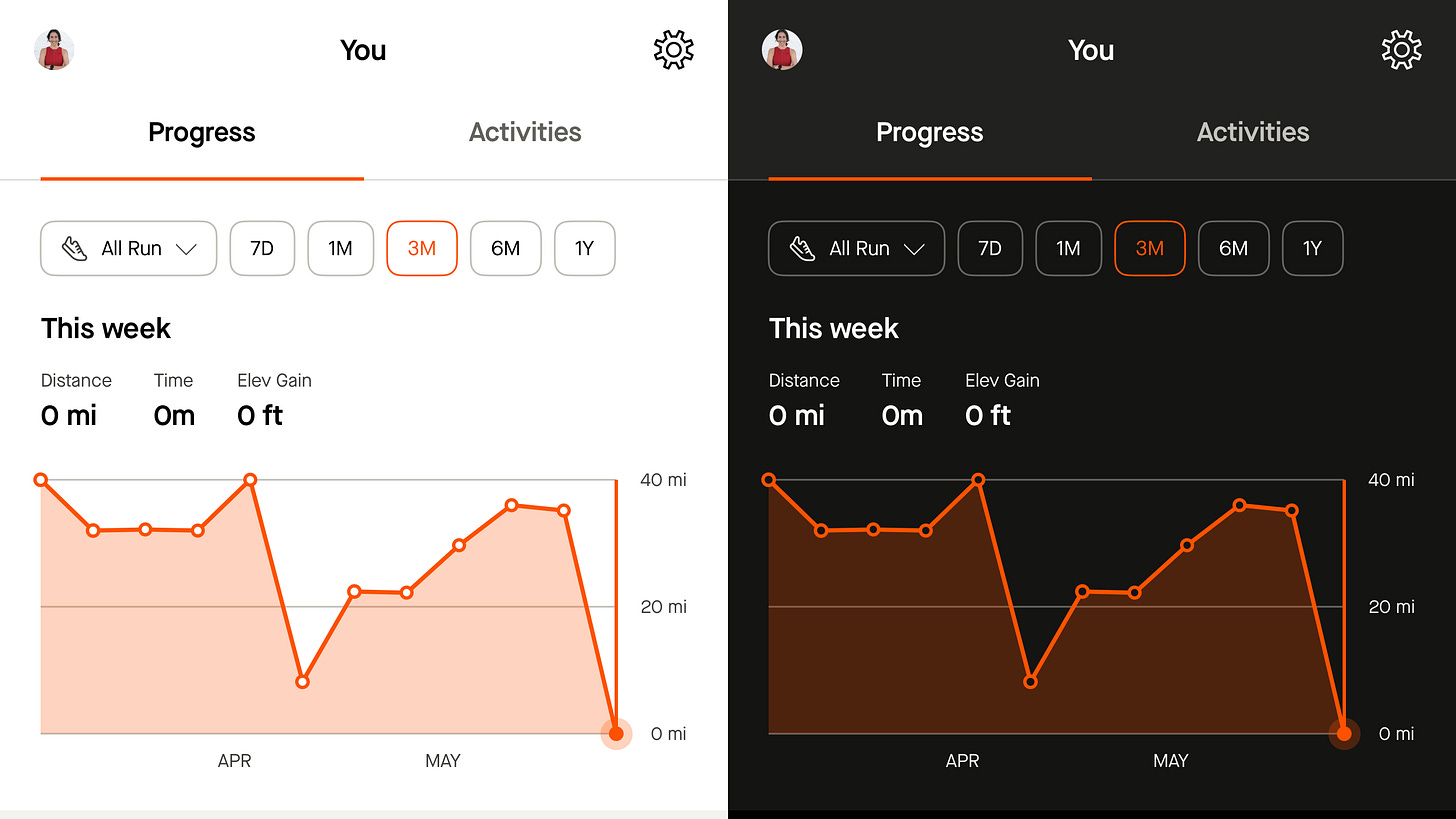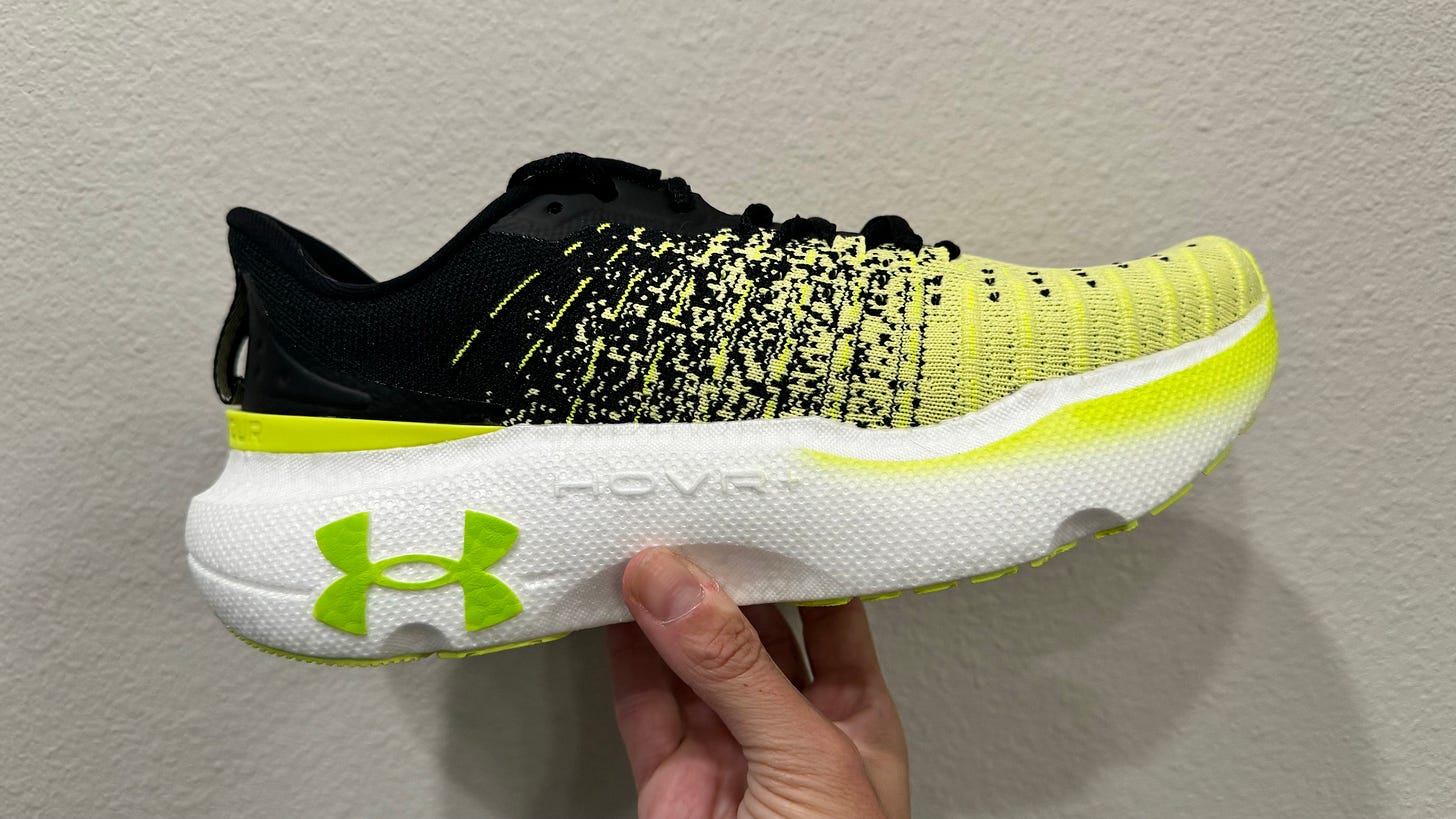Believe it or not, Strava—the ubiquitous fitness tracking-turned-social media platform is 15 years old. Personally, I’m not obsessive about it, but I do use it and I recognize the power it has within the running community. And last week, I got to experience that power firsthand at Strava Camp, a three-day event that brought Strava executives, industry professionals, professional athletes, and influencers together in Los Angeles for trail runs, bike rides, panels, and networking.
There were several big announcements from the fitness platform, including the launch of one of the company’s most requested features, Dark mode. I tried it, I don’t totally get the hype, but I guess it’s cool that you can choose to keep your app settings always dark, always light, or match it to your device settings.
There are also two new features that will appeal specifically to women: Night Heatmaps and Quick Edit. Night Heatmaps show only activities between sundown and sunrise so you can get a sense of which roads, trails, and paths are well-trafficked in the dark (FYI: this will only be available to subscribers). Quick Edit gives users more control over what information they share publicly on Strava, like your start time, your map, or other workout stats.
I was most interested in the implementation of artificial intelligence. The first update there is AI-enabled Leaderboard Integrity, which uses machine learning to automatically flag irregular, improbable, or impossible activities recorded to the platform. But more relevant to the average user is Athlete Intelligence, which turns each subscriber’s training data into an easily digestible summary that contextualizes their accomplishments and fitness goals. Here’s what that looks like:
Strava says “unlike other AI-powered training services, Strava connects with thousands of devices, wearables, and fitness apps, so an athlete’s insights can consider their entire fitness story across multiple sports and modalities.” Based on the first few runs with Athlete Intelligence enabled, the AI mostly seems to be pulling from my activity titles, weather data, heart rate, and speed information; I can’t tell yet how historical training data might be used to provide more nuance to these insights. It’s a cool feature, but definitely one that’s still a work in progress.
While these updates are cool—and will be released on a rolling basis throughout the year—I was more interested in the sense of community that an event like Strava Camp inspires. There were several panels throughout the two days on site, but the best by far was “She’s Got Game: Trailblazing Women In Sport,” with Olympian and World Record holder Colleen Quigley, two-time World Cup champion Tobin Heath, Olympic medalist Alysia Montaño, and moderator Justine Brown, the VP of Creative Development at TOGETHXR. (Strava also announced a partnership with TOGETHXR, which is a media company dedicated to encouraging more women to watch and play women’s sports; I bought their “Everyone Watches Women’s Sports” shirt while this panel was still happening.)
The women spoke at length about what a monumental year it's been for women’s sports, and how this isn’t just a moment but a movement. The “Caitlin Clark effect” is not just limited to basketball (although the women's NCAA championship game was the most watched men’s or women’s game since 2019): A new women’s professional volleyball league made its debut in January, drawing the largest turnout ever for the sport in the United States; the Professional Women's Hockey League also launched in January, setting multiple attendance records throughout their season. And this summer. Paris will be the first Olympic Games to feature an equal number of male and female athletes, with 50 percent participation for each gender.
The Olympics also came up in one of the more poignant moments, when Brown acknowledged that this was Alysia Montaño’s first public appearance since news broke that she would be moved up to the bronze medal position for the 2012 Olympics 800-meter final after Russia’s Ekaterina Poistogova-Guliyev was stripped of her medal for doping. The entire room gave her a standing ovation, and Montaño was in tears; then she eloquently explained the heartbreak of believing she earned that medal, knowing the other athlete was dirty, and losing millions of dollars in sponsorship opportunities after the Games.
The panel really centered around how powerful it is when women use their platforms to speak up—and not just professional athletes. Heath referenced the sense of tribalism among women’s sports fans, and how women need to keep opting in every time in order to keep opening doors. If the goal here was to inspire more content around women’s sports, I’m all in.
That mentality also carried over to the final fireside chat between Olympic sprinter Gabby Thomas and Nick Thompson, CEO of The Atlantic and a world-record setting 50K runner for age 45 and over. Thomas also confirmed that the just-announced 776 Invitational—a September track event that will offer the largest-ever purse for a women-only competition in history—is just the tip of the iceberg; she said, “It’s a precursor to a larger effort, there will be an accompanying league to follow, that is the overarching goal, where athletes do have more control, we do have more say, we do have more power.”
Outside of the new feature announcements and pro athlete appearances, my favorite part of events like this is how they bring together industry people in a mostly organic way that allows ideas and connections to flourish. As a freelancer, I’m often working alone at my computer, so getting to reconnect with those I consider my colleagues and meet new people making an impact within this space is always worth the trip.
the rundown
Under Armour Infinite Elite
When an athlete like Shannon Lokedi storms to second place in the Boston Marathon wearing Under Armour shoes, it makes me want to pay attention to the brand. I finally put the Infinite Elite—a daily trainer, despite the lofty implications of the style name—to the test and I was kind of underwhelmed. There’s nothing bad about it, but there’s also nothing exciting about it. The shoe features the brand’s “newest, springiest UA HOVR+ cushioning,” and there’s a lot of it—40 millimeteres under the heel, to be exact. But it felt more dense and firm than bouncy, which is not my preference, and overall the shoe felt pretty hefty (it’s about 10 ounces). It’s just fine as a daily trainer, but as we move further into the era of super trainers, “just fine” isn’t going to cut it.
“Ahead of Olympics, World Anti-Doping Agency Faces a Trust Crisis”
Speaking of doping, the New York Times recently published an article explaining the cover-up allegations the World Anti-Doping Agency is contending with right now (related to elite Chinese swimmers who medaled at the last Olympic Games), and how that will affect whether the organization can do its job of ensuring an equal playing field in Paris. Not only are athletes questioning WADA, but the top drug official in the Biden administration is calling for an emergency meeting and an independent commission to investigate how past positive tests were handled. If you’re wondering why the U.S. government is involved, it’s because the U.S. contributes more than any other nation—$3.6 million this year—to WADA’s budget. Given the ramifications of doping in sport (see: Alysia Montaño’s story above), there clearly needs to be more accountability from this international regulator.
Plant-Based Diets Do Not Compromise Performance
Good news for vegetarian and vegan runners: Plant-based diets have no detrimental effect on strength and power performance and they actually improve aerobic performance, according to a recent meta-analysis of 10 studies published in the British Journal of Nutrition. The aerobic benefits may be related to increased carbohydrate intake. That said, the study authors did suggest athletes looking to adopt this dietary approach seek out professional guidance to avoid potential health risks, like low energy availability.
Netflix Officially Announces Sprint Documentary Series
We knew it was coming, but last week the streaming giant finally shared more details on the upcoming track docuseries. Now titled Sprint, it follows athletes Sha’Carri Richardson, Noah Lyles, and Shericka Jackson— alongside other runners from the US, Jamaica, the UK, Ivory Coast, Kenya, and Italy—in the leadup to the 2023 World Championships and the 2024 Paris Olympic Games. Six 45-minute episodes will air in July 2024 before track and field starts at the Summer Games on August 1, and it has already been renewed for season 2, which will reportedly consist of four 45-minute episodes that will cover the road to the Paris Olympics.










Dark Mode is long overdue. Using AI to weed out cheaters at segment leaderboard is actually a cool feature.
Things I wish Strava will update in the future:
- Threaded comments : For a social media app, the comment section is still very basic.
- Triathlon as one event: why can't Strava combines all three triathlon event as one sport instead of 3 different activities?
- Shoes sorting: at least give us the option to sort shoes by alphabet for users who use Strava to track shoes mileage. Probably a niche for most user but as someone with 20+ shoes in rotation, it's kinda annoying to have to scroll and choose the right shoes time. 😂
I‘m seriously underwhelmed by these updates. Strava costs quite a bit each month and it works, but there‘s not much innovation going on.